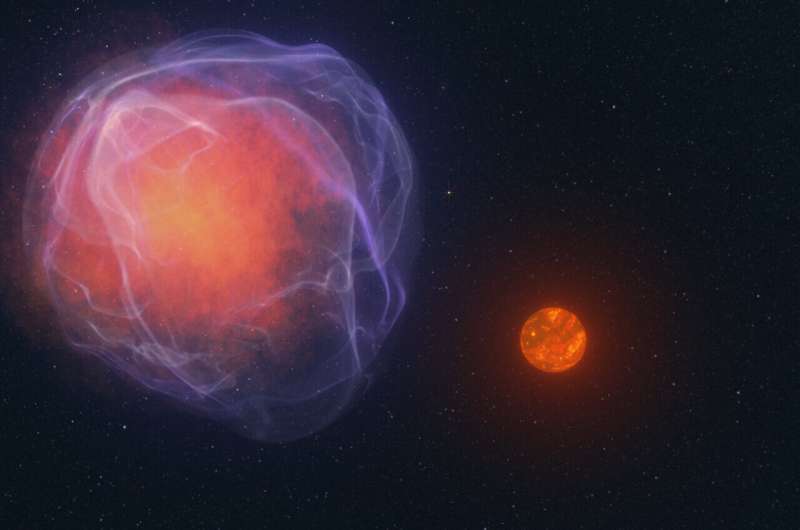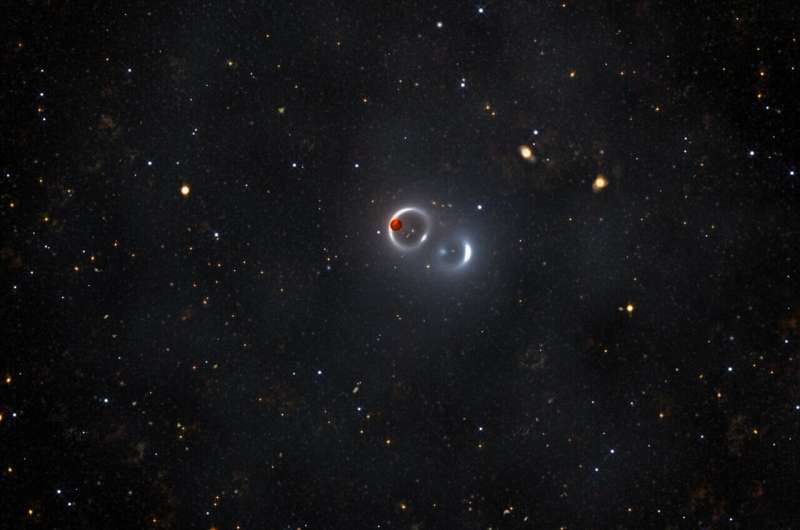This article has been reviewed according to Science X's editorial process and policies. Editors have highlighted the following attributes while ensuring the content's credibility:
fact-checked
peer-reviewed publication
trusted source
proofread
Tracking a newly discovered hypervelocity star spotted by citizen scientists

It may seem like the sun is stationary while the planets in its orbit are moving, but the sun is actually orbiting around the Milky Way galaxy at an impressive rate of about 220 kilometers per second—almost half a million miles per hour.
As swift as that may seem, when a faint red star was discovered moving even faster across the sky, clocking in at a speed of about 1.3 million miles per hour (600 kilometers per second), scientists took notice.
This rare stellar speedster is the first "hypervelocity" very low mass star found, thanks to the efforts of citizen scientists and a team of astronomers from around the country using several telescopes, including two in Hawaiʻi—W. M. Keck Observatory on Maunakea, Hawaiʻi Island and the University of Hawaiʻi Institute for Astronomy Pan-STARRS on Haleakalā, Maui. Located just 400 light-years from Earth, it is the nearest known hypervelocity star to us.
More remarkably, this star may be on an unusual trajectory that could cause it to leave the Milky Way altogether.
The research, led by University of California (UC) San Diego Professor of Astronomy and Astrophysics Adam Burgasser, has recently been accepted for publication in The Astrophysical Journal Letters and is available in preprint format on arXiv.
The star, named CWISE J124909+362116.0 (or "J1249+36" for short), was first spotted by some of the over 80,000 citizen science volunteers participating in the Backyard Worlds: Planet 9 project, who comb through enormous reams of data collected over the past 14 years by NASA's Wide-field Infrared Survey Explorer (WISE) mission.
This project capitalizes on the keen ability of humans, who are evolutionarily programmed to look for patterns and spot anomalies in a way that is unmatched by computer technology. Volunteers tag moving objects in data files and when enough volunteers tag the same object, astronomers investigate.
J1249+36 immediately stood out because it was moving at about .1% the speed of light.
"This is where the source became very interesting, as its speed and trajectory showed that it was moving fast enough to potentially escape the Milky Way," says Burgasser.
To better understand the nature of this object, Burgasser turned to Keck Observatory's Near-Infrared Echellette Spectrograph (NIRES) and measured its infrared spectrum. The data revealed the object was an L subdwarf—a class of stars with very low masses and cooler temperatures than our sun. Subdwarfs represent the oldest stars in the Milky Way.
The team compared Keck Observatory's insight into J1249+36's composition with a new set of atmosphere models created by UC San Diego alumnus Roman Gerasimov, who worked with UC LEADS scholar Efrain Alvarado III to generate models specifically tuned to study L subdwarfs.
"It was exciting to see that our models were able to accurately match the spectrum obtained with Keck's NIRES," says Alvarado.
The spectral data, along with imaging data from Pan-STARRS and several other ground-based telescopes, allowed the team to accurately measure J1249+36's position and velocity in space, and thereby predict its orbit through the Milky Way.
What gave this star a kick?
Researchers focused on two possible scenarios to explain J1249+36's unusual trajectory.
In the first scenario, J1249+36 was originally the low-mass companion of a white dwarf. White dwarfs are the remnant cores of stars that have depleted their nuclear fuel and died out. When a stellar companion is in a very close orbit with a white dwarf, it can transfer mass, resulting in periodic outbursts called novae. If the white dwarf collects too much mass, it can collapse and explode as a supernova.
"In this kind of supernova, the white dwarf is completely destroyed, so its companion is released and flies off at whatever orbital speed it was originally moving, plus a little bit of a kick from the supernova explosion as well," says Burgasser.
"Our calculations show this scenario works. However, the white dwarf isn't there anymore and the remnants of the explosion, which likely happened several million years ago, have already dissipated, so we don't have definitive proof that this is its origin."
In the second scenario, J1249+36 was originally a member of a globular cluster, a tightly bound cluster of stars, immediately recognizable by its distinct spherical shape. The centers of these clusters are predicted to contain black holes of a wide range of masses. These black holes can also form binaries, and such systems turn out to be great catapults for any stars that happen to wander too close to them.

"When a star encounters a black hole binary, the complex dynamics of this three-body interaction can toss that star right out of the globular cluster," says Kyle Kremer, incoming Assistant Professor in UC San Diego's Department of Astronomy and Astrophysics.
Kremer ran a series of simulations and found that on rare occasions these kinds of interactions can kick a low-mass subdwarf out of a globular cluster and on a trajectory similar to that observed for J1249+36.
"It demonstrates a proof of concept," says Kremer, "but we don't actually know what globular cluster this star is from." Tracing J1249+36 back in time puts it in a very crowded part of the sky that may hide undiscovered clusters.
To determine whether either of these scenarios, or some other mechanism, can explain J1249+36's trajectory, Burgasser said the team hopes to look more closely at its elemental composition. For example, when a white dwarf explodes, it creates heavy elements that could have "polluted" the atmosphere of J1249+36 as it was escaping. The stars in globular clusters and satellite galaxies of the Milky Way also have distinct element abundance patterns that may reveal the origin of J1249+36.
"We're essentially looking for a chemical fingerprint that would pinpoint what system this star is from," said Gerasimov, whose modeling work has enabled him to measure the element abundances of cool stars in several globular clusters.
Whether J1249+36's speedy journey was because of a supernova, a chance encounter with a black hole binary, or some other scenario, its discovery provides a new opportunity for astronomers to learn more about the history and dynamics of the Milky Way.
More information: Adam J. Burgasser et al, Discovery of a Hypervelocity L Subdwarf at the Star/Brown Dwarf Mass Limit, arXiv (2024). DOI: 10.48550/arxiv.2407.08578
Journal information: Astrophysical Journal Letters , arXiv
Provided by W. M. Keck Observatory





















